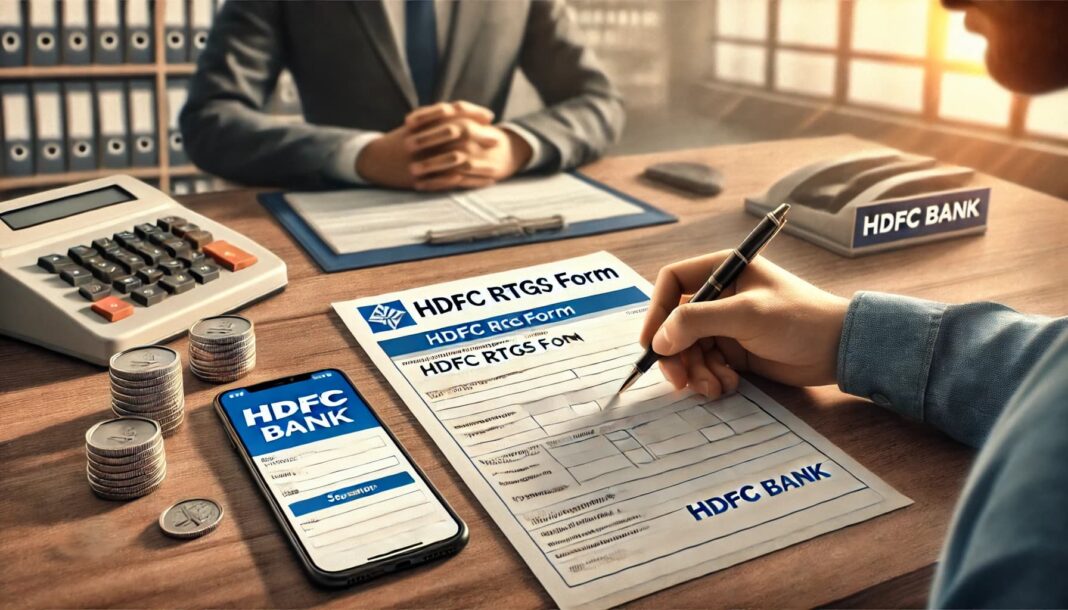In today’s fast-paced world, transferring money securely and quickly is essential, and one of the most reliable ways to do this is through the Real-Time Gross Settlement (RTGS) system. If you’re a customer of HDFC Bank, you may have heard about the HDFC RTGS form but aren’t quite sure how it works or why it’s important. This post will guide you through everything you need to know about the HDFC RTGS form, including its purpose, how to fill it out, and when to use it.
What is RTGS and Why Do You Need the HDFC RTGS Form?
RTGS, or Real-Time Gross Settlement, is a system used for the immediate settlement of high-value transactions between banks. Unlike other methods of transferring money, RTGS processes transactions on a real-time basis and ensures that the money is transferred instantly. This makes it one of the most efficient and secure ways to transfer large sums of money, especially when you need the transaction to be completed without delays.
To make use of RTGS, HDFC Bank requires customers to fill out the RTGS form. The form is a necessary document that provides details about the transaction, such as the sender’s and receiver’s account details, the amount to be transferred, and the reason for the transfer. Completing this form is essential to ensure that the funds are transferred accurately and securely.
When Should You Use the HDFC RTGS Form?
While RTGS is great for transferring large amounts of money, it’s not suitable for all types of transactions. The HDFC RTGS form is typically used when:
- You need to transfer amounts above ₹2 Lakhs.
- The transfer needs to be processed on the same day and should not be delayed.
- You’re transferring funds to another bank in India, as RTGS allows payments across different financial institutions.
It’s important to note that RTGS can only be processed during banking hours, so make sure to submit the form within the bank’s working hours for timely processing.
How to Fill Out the HDFC RTGS Form
Filling out the HDFC RTGS form can seem a bit intimidating at first, but once you break it down into sections, it becomes quite simple. Here’s a step-by-step guide on how to fill it out:
1. Sender’s Information
The first section of the form requires you to fill in your details as the sender. You’ll need to provide:
- Your name
- Your account number
- Your contact details
- The branch name of your HDFC Bank account
2. Receiver’s Information
Next, you’ll need to provide the receiver’s details:
- Receiver’s name
- Receiver’s account number
- Receiver’s bank name and branch
- Receiver’s IFSC code (which is crucial for ensuring that the payment reaches the correct bank and branch)
3. Transaction Details
This section includes:
- The amount to be transferred
- The purpose of the transfer (e.g., payment for goods, services, loan repayment, etc.)
4. Signature
Finally, you’ll need to sign the form to authorize the transaction. Make sure that the signature matches the one registered with the bank.
Where Can You Submit the HDFC RTGS Form?
Once you’ve completed the form, it’s time to submit it. You can do this at the HDFC Bank branch where your account is held. The form can be submitted at the bank counter, and once it’s processed, the funds will be transferred to the recipient’s account almost instantly.
Alternatively, if you’re tech-savvy, you can also initiate the RTGS transfer online through the HDFC Bank NetBanking portal. This digital process doesn’t require you to physically fill out the form, but you’ll still need to provide all the necessary details as part of the online transaction process.
HDFC RTGS Form: Advantages and Disadvantages
While RTGS offers several advantages, it’s important to weigh them against its limitations. Let’s take a quick look:
Advantages:
- Speed: Transactions are processed in real-time, ensuring that the funds are transferred instantly.
- Security: Since RTGS is a secure system used by banks, it’s a highly reliable way to send money.
- Large Transactions: It is ideal for transferring large sums of money, especially amounts above ₹2 Lakhs.
Disadvantages:
- Time Limit: RTGS transfers are only processed during business hours, so if you submit the form after hours, the transaction won’t be processed until the next working day.
- Fees: HDFC Bank may charge a fee for processing RTGS transactions, depending on the amount being transferred.
Is the HDFC RTGS Form Safe to Use?
Absolutely! RTGS is one of the most secure methods of transferring funds, and HDFC Bank adheres to all the necessary security protocols to ensure that the transaction is completed safely. As long as you provide accurate information and follow the process correctly, your funds will be transferred without any issues.
However, always double-check the information you input into the RTGS form, as errors can lead to delays or incorrect transactions. This is why it’s important to verify the receiver’s details, including their account number and IFSC code, before submitting the form.
Conclusion
The HDFC RTGS form is an essential tool for transferring large amounts of money quickly and securely. Whether you’re sending money for business, personal purposes, or paying off a loan, RTGS offers a reliable solution. By following the steps outlined in this post, you can fill out and submit the form with ease. With RTGS processing your transactions in real-time, you can rest assured that your funds will be transferred instantly and securely.
Remember, if you’re not comfortable filling out the form manually, you can always complete the process online through HDFC Bank’s NetBanking portal. Whichever method you choose, the HDFC RTGS form ensures that your high-value transfers are smooth and hassle-free.



